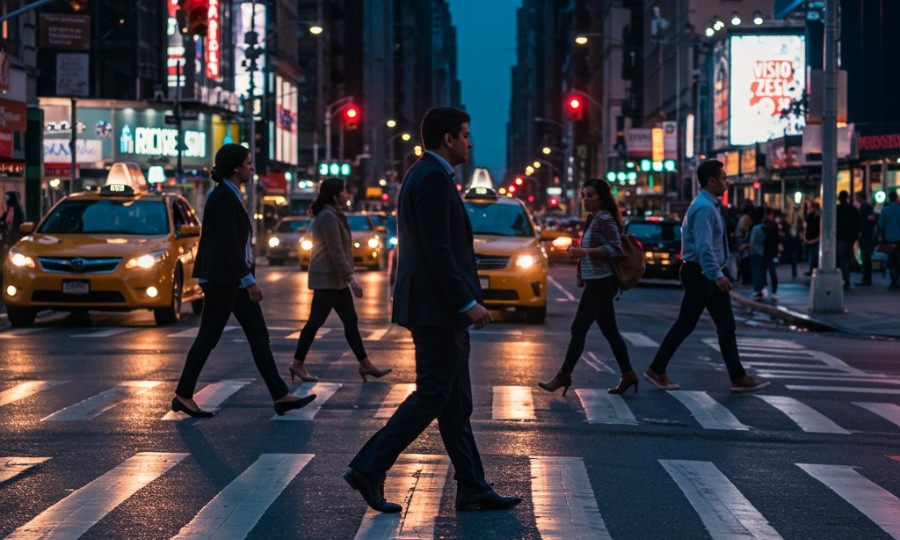
Stepping out in New York City often feels like navigating a vibrant, chaotic dance. The energy is infectious, the opportunities endless, but beneath the hustle, there’s a serious underlying concern for anyone on foot: pedestrian safety. Have you ever paused at a crosswalk, looked both ways (and then a third time!), and thought, “Is this really safe?” You’re not alone. In a city where walking is a primary mode of transport for millions, understanding where the greatest risks lie isn’t just helpful; it’s essential for your well-being. We’re not just talking about minor fender benders here; we’re talking about life-altering incidents.
It’s easy to get complacent, isn’t it? We get caught up in our routines, rushing to work or simply enjoying a stroll, and sometimes we forget the very real dangers that lurk at certain intersections. The truth is, some corners of our beloved city are far more perilous than others for pedestrians. But which ones? And why? Let’s dive into what the data tells us, explore the specific high-risk zones, and discuss what you can do to stay safe.
Unpacking Vision Zero: What NYC’s Data Reveals
New York City isn’t ignoring these issues. In fact, it’s been at the forefront of tackling pedestrian safety with its ambitious Vision Zero program, launched in 2014. The core idea behind Vision Zero is simple yet powerful: traffic fatalities and serious injuries are preventable. It’s a comprehensive strategy that uses data to identify problem areas, implements engineering changes, enhances enforcement, and promotes public education. This initiative has been instrumental in shedding light on where and why New York City pedestrian accidents occur most frequently.
Through Vision Zero, the New York City Department of Transportation (NYC DOT) and the New York Police Department (NYPD) meticulously track crash data. What we consistently see from their reports (which are publicly available, by the way – transparency is key here!) is that certain patterns emerge. For example, a significant number of serious crashes involve left-hand turns by vehicles, or occur at wide, multi-lane intersections where drivers might be tempted to speed. It’s not just about reckless drivers, though that’s certainly a factor; it’s also about road design, visibility, and even the sheer volume of people and vehicles.
The data consistently points to specific corridors and intersections that act as perennial hotspots. While the city has made strides, with a notable reduction in traffic fatalities since Vision Zero’s inception, the work is far from over. Certain areas, despite interventions, remain stubbornly high on the list of dangerous spots. This isn’t just statistics; it’s about real people, real lives. You might be thinking, “But I live in a quiet neighborhood,” and that’s true for many, but even a short journey can take you through one of these high-risk areas.
The City’s Riskiest Corridors: Spotlighting High-Volume Hazards
So, where are these notorious intersections? While danger can strike anywhere, some areas are statistically more prone to pedestrian incidents due to a confluence of factors – high traffic volume, complex road geometries, and often, driver behavior. We’re going to highlight a few of the most challenging areas across different boroughs, drawing on official reports and analyses.
Manhattan’s Midtown Maze and Beyond
Manhattan, with its dense population and constant flow of tourists and commuters, predictably features prominently. While the specific intersections can shift year-to-year based on interventions, major avenues often top the list. Think of areas around Midtown Manhattan, particularly the intersections along 8th Avenue, 3rd Avenue, and 42nd Street. These aren’t just busy; they’re often confusing, with multiple bus lanes, taxi stands, and pedestrians rushing in every direction. Times Square, for all its pedestrianized glory, still sees a high volume of vehicular traffic on its periphery, creating a constant tension.
Another area that often raises concerns is around the Lower Manhattan financial district, especially intersections near key bridges and tunnels where traffic funnels in and out of the borough. Pedestrians often find themselves competing with vehicles making quick turns or accelerating to merge onto highways. It’s a high-stakes environment where a moment’s distraction can have serious consequences.
Brooklyn’s Busy Thoroughfares
Brooklyn, a borough of diverse neighborhoods and bustling commercial strips, also has its share of dangerous spots. Flatbush Avenue, particularly the stretches running through Prospect Lefferts Gardens and Flatbush, is consistently cited as a high-risk corridor. Its wide lanes and significant traffic volume make it challenging for pedestrians, especially at intersections with turning vehicles. Similarly, parts of Atlantic Avenue, especially where it intersects with major cross streets, present similar challenges, often exacerbated by commercial truck traffic.
What makes these areas particularly hazardous? Often, it’s the sheer width of the street, which encourages higher speeds, combined with inadequate pedestrian crossing times or unclear signage. It’s a recipe for disaster, frankly. We’ve seen local community groups constantly advocating for improvements in these very areas, showing that residents are keenly aware of the risks.
The Bronx and Queens: High-Volume Hazards
Moving north, The Bronx’s Grand Concourse, while a historic boulevard, has also been identified as a significant area of concern for pedestrian safety. Its multiple lanes, long blocks, and heavy traffic flow, especially during peak hours, contribute to a high number of incidents. Similarly, Queens Boulevard, famously dubbed the “Boulevard of Death” in past decades due to its exceptionally high fatality rate, has seen significant improvements thanks to Vision Zero efforts. However, some segments, particularly in areas like Elmhurst and Woodside, still warrant extreme caution due to their complex design and heavy traffic.
These examples aren’t meant to scare you, but rather to inform. Knowing is half the battle, right? When you approach these areas, your awareness levels should naturally heighten. It’s not just about avoiding these streets entirely (which often isn’t possible); it’s about being extra vigilant when you’re on them.
Mitigating Risk: Your Role in Pedestrian Safety
While the city works on infrastructure and enforcement, you, as a pedestrian, play a vital role in your own safety. Here are some actionable steps:
- Stay Alert, Always: Put away your phone. Resist the urge to text or scroll while crossing or walking near busy intersections. Distracted walking is a real problem, and it can be just as dangerous as distracted driving.
- Obey Traffic Signals: Don’t start crossing against the light, even if you think you can make it. Drivers often don’t anticipate pedestrians outside of designated crossing times.
- Make Eye Contact: Before stepping into a crosswalk, try to make eye contact with approaching drivers. This simple act can confirm they see you.
- Be Visible: Especially at night or in low-light conditions, wear bright clothing or use reflective gear.
- Understand the Rules (and Limitations): Know that New York State law requires drivers to yield to pedestrians in crosswalks, but don’t assume every driver will. Defensive walking is key.
We know this feels overwhelming sometimes. Navigating a big city can be stressful enough without constantly worrying about your safety. But by understanding the risks and taking proactive steps, you significantly reduce your chances of becoming another statistic. Think about it: a few seconds of heightened awareness could make all the difference, couldn’t it?
Advocating for Change: Beyond Personal Safety
Personal safety is crucial, but systemic change is also vital. How can you contribute? Support local community boards and advocacy groups that push for safer streets. Attend public meetings where infrastructure changes are discussed. Report dangerous intersections or recurring issues to 311 or directly to NYC DOT. Your voice, combined with others, helps to keep pedestrian safety on the city’s agenda.
Ultimately, a safer New York City for pedestrians benefits everyone. It makes our neighborhoods more livable, our commutes less stressful, and our public spaces more enjoyable. By being informed, vigilant, and engaged, we can all contribute to a future where navigating the city on foot is a joy, not a gamble. Let’s work together to make those dangerous intersections a thing of the past.
Free Case Consultation
Injured in an accident? Contact Rosenberg, Minc, Falkoff & Wolff for a free and confidential case review with an experienced NYC personal injury attorney.


